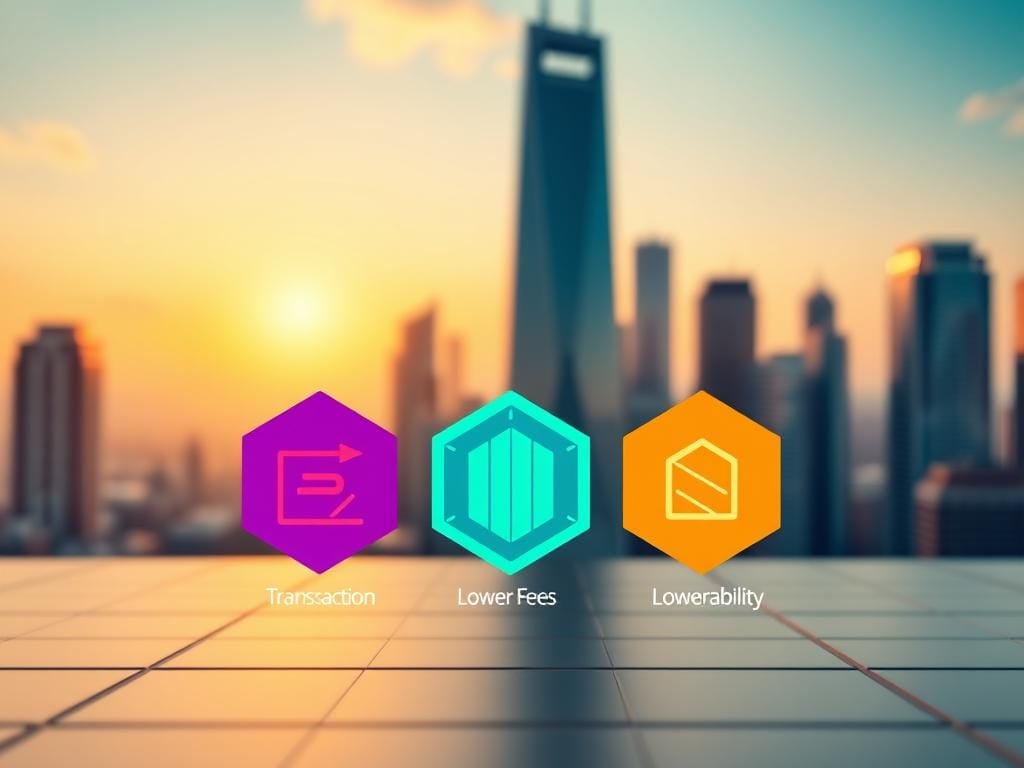Did you know that Layer2 scaling solutions have changed the blockchain world? They now handle millions of transactions every day. This makes network scalability much better.
Blockchain technology is growing fast. It’s used in things like DeFi, NFTs, and on-chain gaming. But, Layer1 blockchains have slow transaction times and high fees. Layer2 solutions fix this by doing work off-chain and posting receipts on-chain. This makes crypto faster, cheaper, and greener, all while keeping Ethereum’s security.
Now, you can enjoy scaling solutions that make transactions faster and more efficient. This makes blockchain apps more accessible and easy to use.
Key Takeaways
- Layer2 scaling solutions process transactions off-chain, making them faster and cheaper.
- These solutions keep the security and decentralization of the Layer1 blockchain.
- By making transactions more efficient, Layer2 solutions make blockchain apps more user-friendly.
- Layer2 scaling has greatly reduced transaction fees.
- Layer2 scaling is key for blockchain technology’s future growth.
Understanding Layer2 Scaling: A Brief Overview
Layer2 scaling solutions aim to fix the problems of Layer1 blockchains. They make data transfer better and improve network efficiency. Let’s dive into how these solutions work and why they’re important in the blockchain world.
What is Layer2 Scaling?
Layer2 scaling means using protocols that handle transactions outside the main blockchain (Layer1). But, they always rely on Layer1 for security and final settlement. This method makes transactions faster and eases the load on the main blockchain, boosting network efficiency.
How Does It Differ from Layer1?
Layer2 scaling solutions are different from Layer1 in many ways. They focus on throughput, transaction fees, security, and data availability. Unlike Layer1, which values decentralization and security, Layer2 aims to increase scalability without losing security.
The main differences between Layer1 and Layer2 are in transaction processing, fees, and security. Layer2 can handle transactions off the main chain. This leads to lower transaction costs and more scalability. It makes Layer2 appealing to users and developers.
The Need for Layer2 Solutions in Blockchain
Blockchain technology is growing, but Layer1 blockchains have big limitations. This shows we need Layer2 solutions. More people want to use blockchain apps, but Layer1 blockchains can’t handle it.

Challenges Faced by Layer1 Blockchains
Layer1 blockchains, like Ethereum and Bitcoin, focus on being decentralized and secure. But, this makes them slow and expensive. They can’t handle many transactions, leading to high transaction fees and slow confirmation times.
Ethereum, once seen as a key player, now faces big scalability issues. High gas fees make transactions expensive. Other Layer1 blockchains have similar problems, showing we need a better solution.
The Impact of High Fees and Slow Transactions
High fees and slow transactions make using blockchain less appealing. It’s expensive and takes too long. This is a big problem for apps that need fast and cheap transactions.
For example, DeFi apps rely on blockchain but are slowed down by these issues. You can learn more about Layer2’s real-world uses in our article on Web3 explained beyond the hype.
Layer2 solutions help by creating a new way to process transactions. This takes the pressure off the main chain. It makes blockchain networks more efficient, allowing for faster and cheaper transactions.
Common Layer2 Scaling Solutions
Blockchain networks need to grow to handle more users and transactions. Layer2 scaling solutions help by making networks faster and more efficient.
State Channels: Instant Transactions
State channels make transactions fast by using smart contracts. They keep a part of the blockchain locked. This lets users make deals without using the main blockchain.
State channels bring many benefits:
- Transactions happen instantly
- Costs for transactions go down
- Users get a better experience
Sidechains: Independent Chains
Sidechains are separate blockchains linked to the main one. They use a two-way peg for asset transfers. This boosts flexibility and scalability.
Sidechains have many advantages:
- They make networks more scalable
- Asset transfers are easier
- Security is better with independent checks
Rollups: Bundling Transactions
Rollups group many transactions together and process them off-chain. They create proofs that show transactions are valid and secure. This makes blockchain networks much faster.

Different types of rollups have their own strengths. They all help make blockchain networks more scalable and efficient.
Key Benefits of Layer2 Solutions
Layer2 solutions make blockchain more efficient, cost-effective, and scalable. They solve the problems of high fees and slow transactions by handling them off-chain.

Enhanced Speed and Efficiency
Layer2 solutions greatly improve transaction speed and efficiency. They move transaction processing off the main chain. This reduces congestion and speeds up transactions.
This is key for apps that need lots of transactions, like Decentralized Finance (DeFi) and gaming.
Lower Transaction Costs
Layer2 solutions also cut down transaction costs. By handling transactions off-chain, they lighten the load on the main chain. This leads to lower fees.
This makes using blockchain apps more affordable. It encourages more people to use them.
Increased Scalability
Layer2 solutions boost scalability, which is vital for blockchain’s growth. They allow more transactions to be processed at once. This supports a variety of applications, from small payments to complex smart contracts.
This scalability is key for blockchain to become widely used.
In short, Layer2 solutions bring many benefits. They improve speed, lower costs, and increase scalability. These advantages make Layer2 solutions appealing for users and developers.
- Improved User Experience: Faster transactions and lower fees make using blockchain better.
- Increased Adoption: Layer2 solutions make blockchain apps more affordable and efficient, leading to more users.
- Broader Applicability: Their scalability supports a wider range of applications and use cases.
Popular Layer2 Protocols You Should Know
Layer2 scaling solutions are changing the blockchain world. Several protocols are leading this change. They make networks faster and cheaper for transactions.
Lightning Network: Bitcoin’s Solution
The Lightning Network is for Bitcoin. It makes small payments fast and cheap. This is great for daily transactions.
It moves transactions off the main blockchain. This reduces congestion and makes Bitcoin more efficient.
Optimistic Rollups: Ethereum’s Approach
Optimistic Rollups are for Ethereum. They group many transactions into one. This is done off-chain before being added to Ethereum.
This method boosts scalability and lowers costs. It makes Ethereum more efficient.
zk-Rollups: Advanced Privacy Features
zk-Rollups, or Zero-Knowledge Rollups, focus on privacy and scalability. They use zero-knowledge proofs. This means transactions are checked without sharing personal info.
This is good for apps that need privacy and security.
To understand these Layer2 protocols better, let’s compare them:
| Protocol | Primary Use | Key Features |
|---|---|---|
| Lightning Network | Bitcoin | Fast, low-cost micropayments |
| Optimistic Rollups | Ethereum | Scalable, cost-effective transaction processing |
| zk-Rollups | Ethereum and others | Advanced privacy, scalable transaction processing |
Each protocol has its own strengths and uses. Knowing these differences is key for developers and users.

How Layer2 Scaling Enhances User Experience
Layer2 scaling makes blockchain apps better by improving network traffic. It does this through methods that make transactions faster and more efficient.
Fast and Seamless Transactions
Layer2 scaling makes transactions fast and seamless. This is key for apps that need quick actions, like games and DeFi. It keeps the main blockchain from getting too busy, so transactions happen quickly.
The table below shows how Layer2 makes transactions faster than Layer1:
| Transaction Characteristic | Layer1 | Layer2 |
|---|---|---|
| Transaction Speed | Slow | Fast |
| Transaction Cost | High | Low |
| Scalability | Limited | High |
Improved Accessibility for Everyday Users
Layer2 also makes blockchain apps easier for everyone to use. It lowers transaction costs, making apps more welcoming. This is key for getting more people involved in blockchain without high fees scaring them off.
As Layer2 scaling grows, we’ll see more ways to make using blockchain better. With fast, seamless, and affordable transactions, Layer2 is making blockchain more open and efficient for everyone.
Potential Drawbacks of Layer2 Solutions
Layer2 scaling has many benefits, but it also has some drawbacks. It’s important to know these limitations when exploring blockchain technology. This knowledge helps you make better choices.
Security Concerns and Risks
Security is a big worry with Layer2 solutions. They depend on the security of the Layer1. If Layer2 has vulnerabilities, the whole system could be at risk. It’s key to have robust security measures and regular audits.
For a better understanding, check out this article. It explains the security issues with Layer2 solutions.
Maintaining Decentralization
Keeping decentralization is also a challenge. Layer2 solutions aim to improve scalability but might lead to centralization. This could cause central points of failure. It’s vital to design Layer2 solutions that keep decentralization intact.
Developers need to think carefully about their Layer2 solutions’ architecture. They should avoid centralization. Using decentralized sequencers or other methods can help. This way, they can improve network scalability and keep the blockchain safe.
The Future of Layer2 Scaling
Blockchain technology is growing fast, and Layer2 scaling solutions are key to its growth. These solutions will make blockchain more scalable and efficient. This is good news for the future of blockchain.
Innovations on the Horizon
Big changes are coming to blockchain, thanks to new Layer2 scaling ideas. Some exciting developments include:
- Improved scaling solutions that make transactions faster and cheaper.
- Stronger security to keep user data safe.
- More ways for different blockchains to work together.
To learn more about Layer2 scaling, check out Ankr’s blog on Layer2 scaling. It offers deep insights into the topic.
Layer2’s Role in the Broader Crypto Ecosystem
Layer2 scaling is more than a quick fix. It’s essential for the crypto world’s future. Layer2 solutions improve network performance by:
- Making blockchain technology more accessible to different industries.
- Helping create more complex and scalable apps, like DeFi and NFTs.
- Creating a better user experience, which will help more people use blockchain.
In summary, the future of Layer2 scaling looks promising. With new ideas, blockchain will become more efficient, secure, and easy to use. We can look forward to better blockchain apps in the future.
Real-World Use Cases of Layer2 Technologies
Layer2 scaling is changing how we use blockchain apps. It makes them faster and easier to use. Many industries are now using Layer2 tech to improve their work and user experience.
Gaming and NFTs
Gaming and NFTs (Non-Fungible Tokens) are big winners with Layer2. It helps with quick and cheap transactions. This is great for in-game economies and fun experiences.
NFT Marketplaces are using Layer2 to cut costs and keep users interested. Sites like OpenSea and Rarible are looking into Layer2 to better their services.
Decentralized Finance (DeFi) Applications
DeFi apps also benefit a lot from Layer2. It makes transactions faster and safer. This opens up more financial services and apps.
| DeFi Application | Layer2 Benefit | Impact |
|---|---|---|
| Lending Platforms | Fast and low-cost transactions | Increased liquidity and user adoption |
| Decentralized Exchanges (DEXs) | Scalable transaction processing | Enhanced trading experiences and reduced slippage |
| Yield Farming Protocols | Secure and efficient transactions | Increased yield and reduced operational costs |
By using Layer2, DeFi apps can work better and feel better to users. This helps them grow and attract more people.
Getting Started with Layer2 Solutions
When you start with Layer2 scaling solutions, picking the right one is key. You must weigh the pros and cons of each, like security, scalability, and ease of use. This ensures a smooth and efficient experience.
Choosing the Right Layer2 Solution
Think about your application type, transaction volume, and security needs when picking a Layer2 solution. For example, gaming or DeFi apps need a solution that boosts data transfer and handles lots of transactions.
Key Considerations for Implementation
Scaling Layer2 protocols is vital for better blockchain app performance. Knowing the different scaling options and their impact on data transfer helps you make the best choice for your project.
FAQ
What is Layer2 scaling, and how does it differ from Layer1?
Layer2 scaling helps blockchain networks handle more transactions by processing them off the main chain. This reduces congestion and boosts speed. Unlike Layer1, which focuses on decentralization and security, Layer2 aims to increase scalability without losing security.
Why are Layer2 solutions necessary for blockchain technology?
Layer2 solutions are needed because Layer1 blockchains struggle with fast and affordable transactions. They are limited in how many transactions they can handle.
What are some common Layer2 scaling solutions?
Common solutions include state channels, sidechains, and rollups like optimistic and validity rollups. These bundle transactions and process them off-chain.
How do Layer2 solutions improve transaction speeds and costs?
By moving transaction processing off the main chain, Layer2 solutions make transactions faster and cheaper. This makes the blockchain ecosystem more efficient and scalable.
What are some popular Layer2 protocols?
Popular protocols include the Lightning Network for Bitcoin and Optimistic and zk-Rollups for Ethereum. Each offers unique benefits for secure and scalable transaction processing.
How does Layer2 scaling enhance the user experience in blockchain-based applications?
Layer2 scaling makes transactions fast and seamless. This makes blockchain apps more interactive and responsive, perfect for real-time interactions.
What are some possible drawbacks of Layer2 solutions?
Drawbacks include security concerns and the need to keep decentralization. Any weakness in Layer2 can threaten the whole system’s security.
How can users and developers get started with Layer2 solutions?
Users and developers should weigh the pros and cons of different solutions. They should consider security, scalability, and usability to pick the best Layer2 solution for their needs.
What is the future of Layer2 scaling?
The future looks bright for Layer2 scaling. Ongoing innovations will help blockchain technology become more widely used. This will support a wider range of applications and use cases.
What are some real-world use cases of Layer2 technologies?
Layer2 technologies have many uses in gaming, NFTs, and DeFi. They enable fast and low-cost transactions. This supports complex in-game economies and interactive experiences.






